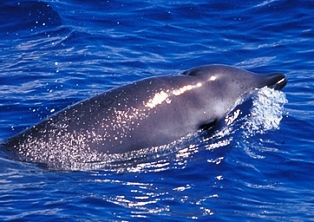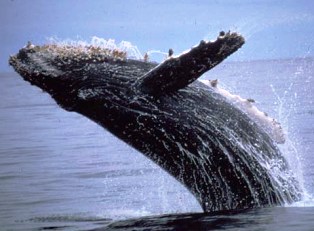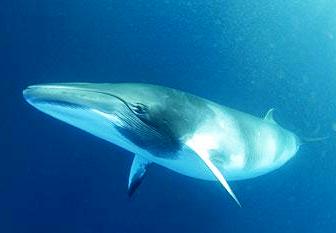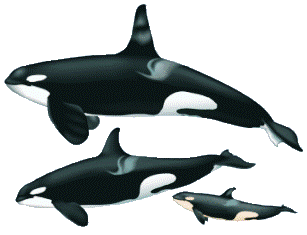Discover Florida Nature
It's time to explore the natural Florida


|
|
|
|
|
 Gervais'
Beaked Whale- Gervais' beaked whales, sometimes called the
"Antillean" or "Gulf Stream beaked whale," are little known members of
the beaked whale family. As adults, Gervais' beaked whales can reach
estimated lengths of about 15-17 ft and weigh at least 2,640 lbs.
Females may be slightly larger than males. Males can be distinguished
from females and juveniles by a pair of visible teeth that erupt from
the front portion of the bottom jaw. Females and juveniles have teeth as
well, but they remain hidden beneath the gum tissue of the mouth. The
jaw line is typically straight or slightly curved. Gervais' beaked
whales are usually found individually or in small closely associated
social groups. While diving, they use suction to feed mainly on
cephalopods, such as squid, along with mysid shrimp, and small fish in
deep water. Gervais' beaked whales prefer deep tropical, subtropical,
and warm temperate waters of the Atlantic Ocean, such as Florida Gulf of
Mexico, but are occasionally found in colder temperate seas. Gervais'
beaked whales have a relatively small to medium size body with a
moderately long beak and an indistinct sloping "melon". They have a
small, triangular, wide-based, slightly "falcate", "dorsal" fin located
far down the animal's back. The coloration of the body is dark gray or
bluish to black with a paler ventral side. Animals tend to become darker
as they age. Mature males may also have linear scars from battles over
females. This species of beaked whale is difficult to observe and
identify at sea due to a low profile at the surface and a small,
inconspicuous blow. Gervais'
Beaked Whale- Gervais' beaked whales, sometimes called the
"Antillean" or "Gulf Stream beaked whale," are little known members of
the beaked whale family. As adults, Gervais' beaked whales can reach
estimated lengths of about 15-17 ft and weigh at least 2,640 lbs.
Females may be slightly larger than males. Males can be distinguished
from females and juveniles by a pair of visible teeth that erupt from
the front portion of the bottom jaw. Females and juveniles have teeth as
well, but they remain hidden beneath the gum tissue of the mouth. The
jaw line is typically straight or slightly curved. Gervais' beaked
whales are usually found individually or in small closely associated
social groups. While diving, they use suction to feed mainly on
cephalopods, such as squid, along with mysid shrimp, and small fish in
deep water. Gervais' beaked whales prefer deep tropical, subtropical,
and warm temperate waters of the Atlantic Ocean, such as Florida Gulf of
Mexico, but are occasionally found in colder temperate seas. Gervais'
beaked whales have a relatively small to medium size body with a
moderately long beak and an indistinct sloping "melon". They have a
small, triangular, wide-based, slightly "falcate", "dorsal" fin located
far down the animal's back. The coloration of the body is dark gray or
bluish to black with a paler ventral side. Animals tend to become darker
as they age. Mature males may also have linear scars from battles over
females. This species of beaked whale is difficult to observe and
identify at sea due to a low profile at the surface and a small,
inconspicuous blow. Humpback
Whale-
The humpback whale is a baleen whale that sings amazing songs. It
performs complex and cooperative feeding techniques. The humpback has a
bulky head with bumpy protuberances (tubercles), each with a bristle.
Humpbacks are acrobats of the ocean, breaching and slapping the water.
They live in pods and have 2 blowholes. The name humpback describes the
motion it makes as it arches its back out of the water in preparation
for a dive. Humpback whales grow to be about 52 feet long, weighing
30-50 tons. The females are slightly larger than males, as with all
baleen whales. The four-chambered heart of the average humpback whale
weighs about 430 pounds! Humpbacks come in 4 different color schemes,
ranging from white to gray to black to mottled. An average-sized
humpback whale will eat 4,400-5,500 pounds of plankton, krill and small,
schooling fish each day during the feeding season in cold waters.
Humpback whales live at the surface of the ocean, both in the open ocean
and shallow coastline waters. When not migrating, they prefer shallow
waters. They migrate from warm tropical waters, such as waters off the
Florida coast, where they breed and calve to arctic waters where they
eat. The humpback whale is listed as an
endangered species in Florida. Humpback
Whale-
The humpback whale is a baleen whale that sings amazing songs. It
performs complex and cooperative feeding techniques. The humpback has a
bulky head with bumpy protuberances (tubercles), each with a bristle.
Humpbacks are acrobats of the ocean, breaching and slapping the water.
They live in pods and have 2 blowholes. The name humpback describes the
motion it makes as it arches its back out of the water in preparation
for a dive. Humpback whales grow to be about 52 feet long, weighing
30-50 tons. The females are slightly larger than males, as with all
baleen whales. The four-chambered heart of the average humpback whale
weighs about 430 pounds! Humpbacks come in 4 different color schemes,
ranging from white to gray to black to mottled. An average-sized
humpback whale will eat 4,400-5,500 pounds of plankton, krill and small,
schooling fish each day during the feeding season in cold waters.
Humpback whales live at the surface of the ocean, both in the open ocean
and shallow coastline waters. When not migrating, they prefer shallow
waters. They migrate from warm tropical waters, such as waters off the
Florida coast, where they breed and calve to arctic waters where they
eat. The humpback whale is listed as an
endangered species in Florida. Minke
Whale- Minke whales grow to be about 25-30 feet long, weighing
about 6-7.5 tons. Females are about 2 feet longer than males, as with
all baleen whales. The largest minke whale was about 35 feet long
weighing 9.5 tons. Minke whales have a snout that is distinctively
triangular, narrow, and pointed, which is how the Minke whale got its
nicknames "sharp-headed finner" and "little piked whale". The minke
whale's skin is very dark gray above and lighter below, sometimes with
pale trapezoidal stripes behind the flippers on the top, and they have a
characteristic white band on each flipper. Minke whales either travel
singly or congregated in small pods of about 2-3 whales. Minke whales
live at the surface of the ocean in all but polar seas. Minke whales,
like all baleen whales, are seasonal feeders and carnivores, filtering
out small polar plankton, krill, and small fish, even chasing schools of
sardines, anchovies, cod, herring, and capelin. Minke whales breathe air
at the surface of the water through 2 blowholes located near the top of
the head. At rest, minke whales spout about 5-6 times per minute. The
spout of the minke whale is a very low, almost inconspicuous stream that
rises up to 6.5 feet above the water. Minke whales start to exhaling
before they reach the surface; this minimizes the blow. Minke
Whale- Minke whales grow to be about 25-30 feet long, weighing
about 6-7.5 tons. Females are about 2 feet longer than males, as with
all baleen whales. The largest minke whale was about 35 feet long
weighing 9.5 tons. Minke whales have a snout that is distinctively
triangular, narrow, and pointed, which is how the Minke whale got its
nicknames "sharp-headed finner" and "little piked whale". The minke
whale's skin is very dark gray above and lighter below, sometimes with
pale trapezoidal stripes behind the flippers on the top, and they have a
characteristic white band on each flipper. Minke whales either travel
singly or congregated in small pods of about 2-3 whales. Minke whales
live at the surface of the ocean in all but polar seas. Minke whales,
like all baleen whales, are seasonal feeders and carnivores, filtering
out small polar plankton, krill, and small fish, even chasing schools of
sardines, anchovies, cod, herring, and capelin. Minke whales breathe air
at the surface of the water through 2 blowholes located near the top of
the head. At rest, minke whales spout about 5-6 times per minute. The
spout of the minke whale is a very low, almost inconspicuous stream that
rises up to 6.5 feet above the water. Minke whales start to exhaling
before they reach the surface; this minimizes the blow.  Orca-
The orca is a stout, streamlined animal. It has a round head that is
tapered, with an indistinct beak and straight mouth line. The orca, or
killer whale, with its striking black and white coloring, is one of the
best known of all the cetaceans. It has been extensively studied in the
wild and is often the main attraction at many sea parks and aquaria. An
odontocete, or toothed whale, the orca is known for being a carnivorous,
fast and skillful hunter, with a complex social structure and a
cosmopolitan distribution (orcas are found in all the oceans of the
world). Sometimes called "the wolf of the sea", the orca can be a fierce
hunter with well-organized hunting techniques, although there are no
documented cases of killer whales attacking a human in the wild.
Males can grow as large as 32 feet long and weigh 8 to 9 tons. Females
can reach 23 feet in length and weigh up to 4 tons.
The mouth of the orca is large and well adapted for hunting. It has 46
to 50 conical shaped teeth that point slightly backwards and inwards.
The upper and lower teeth interlock, which aids in gripping large prey
and tearing it into smaller pieces for easier swallowing.
The orca is found in all the oceans of the world, though they are more
abundant in cooler waters. Unlike some other species of whales, which
follow a regular migration route each year, the orca seems to travel
according to the availability of food. They are one of the few species
of whales that move freely from hemisphere to hemisphere. Orca-
The orca is a stout, streamlined animal. It has a round head that is
tapered, with an indistinct beak and straight mouth line. The orca, or
killer whale, with its striking black and white coloring, is one of the
best known of all the cetaceans. It has been extensively studied in the
wild and is often the main attraction at many sea parks and aquaria. An
odontocete, or toothed whale, the orca is known for being a carnivorous,
fast and skillful hunter, with a complex social structure and a
cosmopolitan distribution (orcas are found in all the oceans of the
world). Sometimes called "the wolf of the sea", the orca can be a fierce
hunter with well-organized hunting techniques, although there are no
documented cases of killer whales attacking a human in the wild.
Males can grow as large as 32 feet long and weigh 8 to 9 tons. Females
can reach 23 feet in length and weigh up to 4 tons.
The mouth of the orca is large and well adapted for hunting. It has 46
to 50 conical shaped teeth that point slightly backwards and inwards.
The upper and lower teeth interlock, which aids in gripping large prey
and tearing it into smaller pieces for easier swallowing.
The orca is found in all the oceans of the world, though they are more
abundant in cooler waters. Unlike some other species of whales, which
follow a regular migration route each year, the orca seems to travel
according to the availability of food. They are one of the few species
of whales that move freely from hemisphere to hemisphere.
|
|
|
Advertise | Privacy Statement | Dog Encyclopedia | Video |Contact | Alaska Nature |
|